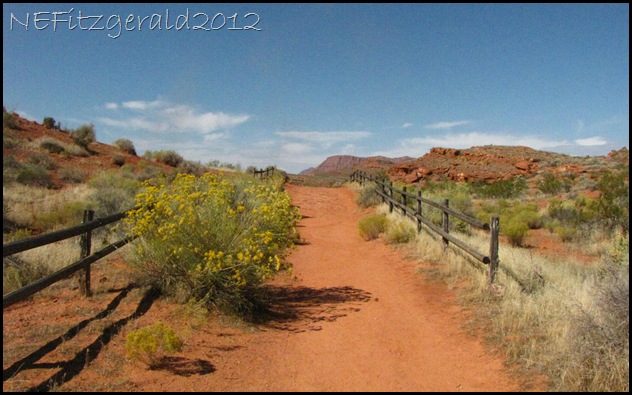Mystery question of the day:
What is this crumbly white rock scattered all over the red sand, and what do you think it’s doing along the Gila Trail?
 |
| What is all this white rock doing in this red sand? |
The history of the mystery:
Three cheery friends get together to take a lovely hike one recent sunny winter day…
 |
| Three cheery friends – COC, JC, NF |
Our trail meanders for seven miles through boulder–strewn hillsides and rolling sandy flats of the Red Cliffs Desert Reserve in (where else?) southwestern Utah.
 |
| Gila Trail |
We are surrounded by ancient red sandstone of fossilized dunes. No surprises there!
 |
| Fossil dunes with toupee of black basalt |
Along a portion of the trail, we notice the previously mentioned crumbly white rock in all this red sand.
We all take a closer look.
 |
| Mystery white rock |
JC picks up a sandwich of the mysterious white rock.
 |
| Inquiring minds want to know! |
What’s this? He inquires quizzically.
It looks like limestone to me, I say authoritatively.
But secretly I wonder – What is limestone doing in all this sandstone?
Now it’s time for fun with chemistry!
I subject this mystifying sample to careful chemical analysis in order to determine its likely composition.
 |
| When in doubt, bring out the dilute hydrochloric acid |
A mere drop makes the rock fizz and bubble like surf breaking on a shoreline.
 |
| Limestone reacts readily to hydrochloric acid |
It certainly is limestone.
Hey!
What is limestone doing here in all this red rock sandstone?
All is revealed (well, maybe):
Horizontally bedded red siltstones and sandstones of the Early Jurassic Kayenta Formation are seen in many places in southern Utah. They outcrop as crumbling ledges and slopes just beneath the massive cliffs of the world famous Navajo Sandstone. These ledges and slopes tell a story of an environment that existed around 190 million years ago. In a Utah that existed during a different geologic time than our own, slow–moving rivers and streams coursed across broad floodplains and undulating lowlands far from their headwaters.
In these ancient mudstones and siltstones the presence of small freshwater lakes and ponds is indicated by thin lenses of limestone found scattered between the layers of rock.
So could our limestone be an eroded remnant from one of these ancient ponds or lakes?
That definitely seems like a reasonable explanation to me.
If someone has any other bright ideas I would love to know about them!
Is there anything you have unexpectedly discovered during your adventures both near and far, geologic or otherwise? Leave a comment!
 |






